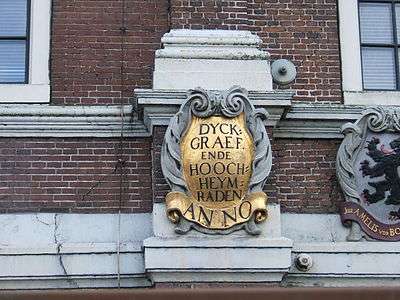Dijkgraaf (official)

The first of a series of gablestones on a Gemeenlandshuis in Halfweg built in 1645; each stone represents the heraldic shield of the dike-reeve and his men, known as the heemraden, or in this case, the high or hoogheemraden
A dijkgraaf (translated: dike-warden or dike-reeve), sometimes called a watergraaf, is the chair of a Dutch water board. He is the equivalent of a mayor in local government and a King's Commissioner in provincial government, chairing both the legislative and executive council, while having both ceremonial and representational roles as well as his own portfolios. The term goes back to pre-medieval days.
Literally the term means "Dike count", like other titles ending in -graaf (equivalent to English -grave and German -graf) of feudal origin, but remained a functional official. The government bodies in the Netherlands today in order of rank are:
- National
- Provincial
- Municipal
- Water boards. In medieval times and earlier however, the water boards were the same as municipal, and since it was a country of duchies, the Water board (Waterschap) was in governmental terms the equivalent of a city (Stad), and thus also the highest form of government.
References
- Dijkgraaf definition (Dutch)
- Water Canon (English version) website of The Ministry of Transport, Public Works and Water Management
| ||||||||||||||||||||||
This article is issued from Wikipedia - version of the 11/13/2015. The text is available under the Creative Commons Attribution/Share Alike but additional terms may apply for the media files.